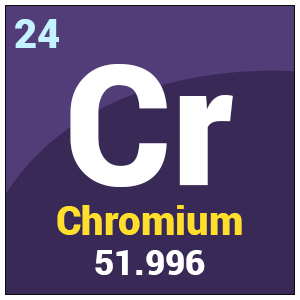
| Symbol | Cr |
| Atomic Number | 24 |
| Atomic Mass | 51.996 g.mol -1 |
| Discovered by | Vaughlin in 1797 |
The Electronic configuration of chromium is [Ar]3d5 4s1.
Chemical Properties Of Chromium
| Group | 6 | Melting point | 1907 °C |
| Period | 4 | Boiling point | 2672 °C |
| Block | d | Density (g cm−3) | 7.19 g.cm-3 at 20°C |
| Atomic number | 24 | Relative atomic mass | 51.996 |
| State at 20°C | Solid | Key isotopes | 52Cr |
| Electron configuration | [Ar]3d5 4s1 | CAS number | 7440-47-3 |
| ChemSpider ID | 22407 | ChemSpider is a free chemical structure database | |
What is Chromium?
- Chromium is a chemical element with atomic number 24 and represented by the symbol Cr in the Periodic Table.
- Chromium is a lustrous, hard metal that has a silver-grey colour. It has a high melting point.
- The electron configuration of chromium is [Ar]3d54s1, which can be explained by the stability offered by a half-filled d-orbital.
- Trivalent chromium is a vital nutrient that is found in traces of sugar, human insulin, and lipid metabolism.
Uses Of Chromium
- Electroplating – It is one of the important uses of chromium. Have you seen the shiny caps over the tires of a car? That shiny plating is made using chromium.
- Emeralds – A small amount of chromium is found in the crystal lattice structure of expensive gems like the emerald.
- New alloys – are formed using chromium. You might have seen chromium on the outside, but it is also mixed with metals to form alloys. Stainless steel and aluminium alloys use a small amount of chromium.
- Paints and Dyes – This useful element is also found in paint and dyes and chemical makeup that is used for fabrics.
Properties Of Chromium
- Chromium burns when heated and the compound that it forms is a green chromic oxide.
- Chromium protects the metal below by immediately producing a thin oxide layer that is impermeable to oxygen.
- One of the important characteristics of chromium is that it won’t get rusted easily, and thus this element is great for electroplating.
Certain Facts About Chromium
- Chromium was used by ancient Chinese.
- About eighty per cent of chromium that is produced annually goes towards the production of metal alloy.
Ferrochromium alloy is commercially produced by silicothermic or aluminothermic reactions from chromite and chromium metal by processes of roasting and leaching followed by carbon and then aluminium reduction. For its elevated corrosion resistance and hardness, chromium metal is of high value. The discovery that steel could be made highly resistant to corrosion and discolouration by adding metallic chromium to form stainless steel was a major development in steel production. Together, stainless steel and chrome plating (electroplating with chromium) account for 85% of industrial use.
The chromium metal left in the air is passivated, creating a thin, protective oxide surface layer. This layer has a spinal structure, with just a few dense atomic layers. It is very thick and prevents oxygen diffusion through the metal underlying it. In addition, iron forms a more porous oxide through which oxygen can migrate, causing continued rusting. A brief interaction with oxidising acids such as nitric acid can improve passivation. Passivated chromium is stable against acids. With a powerful reducing agent that removes the protective oxide layer on the metal, passivation can be removed. This treated chromium metal readily dissolves in weak acids.
Recommended Videos

Frequently Asked Questions – FAQs
What is chromium element used for?
Chromium and other alloys are used in stainless steel. For example, on cars and bicycles, chromium plating creates a smooth, silver finish that is highly corrosion resistant. The metal is commonly used as a catalyst as well. Chromium compounds are prized for their bright colours of green, purple, red and orange as pigments.
What family does chromium belong to?
On the Periodic Table of Elements, chromium is a transition metal in Group 6. Chromium, in its pure form, is a silvery, lustrous, hard metal with a large finish that is suitable for electroplating.
Is chromium toxic to humans?
The health risks associated with chromium exposure are based on its state of oxidation. The form of the metal (chromium as it appears in this product) has a low toxicity level. The hexavalent form is poisonous. Ulcerations, dermatitis, and allergic skin reactions can involve adverse effects of the hexavalent form on the skin.
What diseases can be caused by chromium?
Via inhalation and dermal path, Chromium is extremely toxic and causes lung cancer, nasal inflammation, nasal ulcer, and hypersensitivity reactions such as contact dermatitis and asthma. Chromium has an effect on different aspects of the immune system which may contribute to immunostimulation or immunosuppression.
What common compounds is chromium found in?
Sodium chromate, potassium chromate, potassium dichromate, ammonium dichromate and chromium trioxide are hexavalent chromium compounds that are widely produced.




Comments